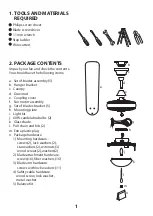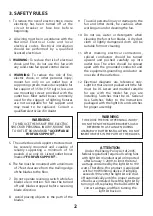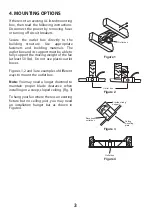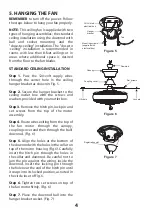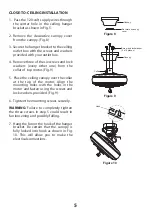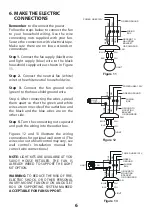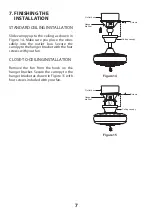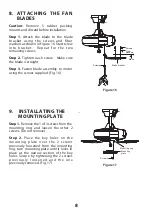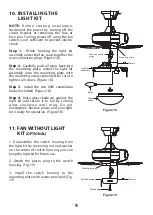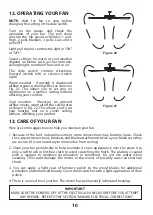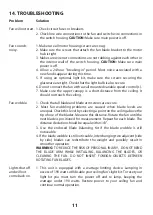
10
Figure 20
Figure 21
12. OPERATING YOUR FAN
NOTE:
Wait for fan to stop before
changing the setting of the slide switch.
Turn on the power and check the
operation of your fan. The pull chain
controls the fan speed as follows: 1 pull-
High, 2 pulls-Medium, 3 pulls- Low, and 4
pulls-Off.
Light pull chain it controls the light in "ON"
or "OFF".
Speed settings for warm or cool weather
depend on factors such as the room size,
ceiling height, number of fans and so on.
The slide switch controls directions:
forward (switch left) or reverse (switch
right)
Warm weather - (Forward) A downward
airflow creates a cooling effect as shown in
Fig. 21. This allows you to set your air
conditioner on a warmer setting without
affecting your comfort.
Cool weather - (Reverse) An upward
airflow moves warm air off the ceiling area
as shown in Fig. 22. This allows you to set
your heating unit on a cooler setting
without affecting your comfort.
Here are some suggestions to help you maintain your fan
1. Because of the fan's natural movement, some connections may become loose. Check
the support connections, brackets, and blade attachments twice a year. Make sure they
are secure. (It is not necessary to remove fan from ceiling.)
2. Clean your fan periodically to help maintain its new appearance over the years. Use
only a soft brush or lint-free cloth to avoid scratching the finish. The plating is sealed
with a lacquer to minimize discoloration or tarnishing. Do not use water when
cleaning. This could damage the motor, or the wood, or possibly cause an electrical
shock.
3. You can apply a light coat of furniture polish to the wood blades for additional
protection and enhanced beauty. Cover small scratches with a light application of shoe
polish.
4. There is no need to oil your fan. The motor has permanently lubricated bearings.
13. CARE OF YOUR FAN
IMPORTANT
MAKE SURE THE POWER IS OFF AT THE ELECTRICAL PANEL BOX BEFORE YOU ATTEMPT
ANY REPAIRS. REFER TO THE SECTION "MAKING ELECTRICAL CONNECTIONS".


